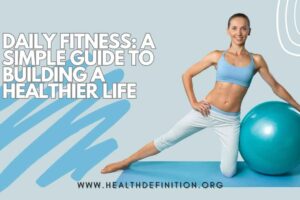
Benefits of Exercise: Exercise is a crucial component of a healthy lifestyle. It not only helps in maintaining physical health but also improves mental well-being. Regular physical activity can prevent a variety of diseases, boost energy levels, and enhance overall quality of life. In this article, we will explore 35 benefits of exercise, categorized into physical, mental, emotional, and social advantages.
Physical Benefits of Exercise
1. Weight Management
Exercise helps in burning calories, which is essential for weight loss and maintaining a healthy weight.
2. Improved Cardiovascular Health
Regular exercise strengthens the heart, lowers blood pressure, and reduces the risk of heart diseases.
3. Enhanced Muscle Strength
Strength training and resistance exercises help in building muscle mass and improving overall strength.
4. Increased Bone Density
Weight-bearing exercises like running and weightlifting enhance bone density, reducing the risk of osteoporosis.
5. Better Joint Health
Low-impact exercises like swimming and yoga can improve joint flexibility and reduce arthritis symptoms.
6. Boosted Immune System
Moderate exercise enhances the immune system, helping the body fight infections more effectively.
7. Increased Stamina and Endurance
Regular physical activity improves cardiovascular endurance and overall stamina.
8. Enhanced Lung Function
Aerobic exercises improve lung capacity and efficiency, making breathing easier.
9. Improved Digestion
Physical activity stimulates digestion and helps prevent constipation and bloating.
10. Better Posture
Strengthening core muscles through exercise improves posture and reduces back pain.
11. Reduced Risk of Chronic Diseases
Exercise lowers the risk of conditions such as diabetes, stroke, and metabolic syndrome.
12. Improved Sleep Quality
Regular exercise promotes better sleep by regulating sleep patterns and reducing insomnia.
13. Slowed Aging Process
Exercise helps in maintaining youthful energy levels, muscle mass, and skin elasticity.
14. Enhanced Flexibility
Stretching and yoga improve flexibility, reducing muscle stiffness and injuries.
15. Better Coordination and Balance
Activities like Pilates and Tai Chi enhance coordination, balance, and overall body control.

Mental and Emotional Benefits of Exercise
16. Reduced Stress Levels
Exercise reduces stress hormones like cortisol and promotes relaxation.
17. Improved Mood
Physical activity stimulates the release of endorphins, which boost mood and reduce anxiety.
18. Enhanced Brain Function
Regular exercise increases blood flow to the brain, improving cognitive function and memory.
19. Lower Risk of Depression
Exercise serves as a natural antidepressant by promoting positive mental health.
20. Increased Self-Esteem
Achieving fitness goals enhances confidence and self-worth.
21. Better Concentration
Exercise improves focus and mental clarity, aiding productivity.
22. Enhanced Creativity
Physical activity stimulates brain function, leading to improved creativity and problem-solving skills.
23. Decreased Risk of Cognitive Decline
Regular exercise reduces the risk of Alzheimer’s disease and other cognitive impairments.
24. Improved Emotional Stability
Exercise helps in managing emotions and reducing mood swings.
25. Greater Resilience to Stress
Physically active individuals handle stress better than sedentary individuals.
Social and Lifestyle Benefits of Exercise
26. Strengthened Relationships
Exercising with friends or family strengthens social bonds and enhances relationships.
27. Increased Social Interaction
Joining fitness classes or sports teams fosters socialization and community involvement.
28. Enhanced Work Performance
Exercise improves energy levels and focus, leading to better work productivity.
29. More Active Lifestyle
Regular exercise encourages an overall active and adventurous lifestyle.
30. Improved Time Management
People who exercise regularly are often more disciplined and better at managing their time.
31. Increased Motivation
Exercise fosters a proactive attitude, boosting motivation in other areas of life.
32. Healthier Eating Habits
Regular exercisers tend to make healthier food choices and maintain a balanced diet.
33. Better Sexual Health
Exercise improves blood circulation, boosts libido, and enhances overall sexual well-being.
34. Longevity and Quality of Life
Physically active individuals tend to live longer and enjoy a higher quality of life.
35. A Sense of Accomplishment
Achieving fitness goals fosters a sense of achievement and personal satisfaction.

How does exercising benefit you?
Exercising has numerous benefits for both your physical and mental health. Here are some key benefits:
Physical Benefits:
- Improves Cardiovascular Health: Regular exercise strengthens the heart, improving blood circulation and lowering the risk of heart disease, high blood pressure, and stroke.
- Boosts Muscle and Bone Strength: Weight-bearing exercises like walking, running, or strength training increase muscle mass and bone density, which can help prevent osteoporosis and muscle loss as you age.
- Regulates Weight: Exercise helps burn calories, which is key in managing weight and preventing obesity. It also helps increase metabolism, making it easier to maintain a healthy weight.
- Improves Flexibility and Coordination: Activities like yoga or stretching improve your flexibility and coordination, helping reduce the risk of falls, especially as you age.
- Enhances Immune System: Regular moderate exercise strengthens the immune system, making you less susceptible to illnesses.
Mental Health Benefits:
- Reduces Stress and Anxiety: Exercise triggers the release of endorphins, the body’s natural mood elevators, helping to reduce stress and anxiety.
- Improves Sleep: Regular physical activity can help you fall asleep faster and improve the quality of your sleep.
- Boosts Self-Esteem and Confidence: Exercise can help you feel better about yourself, improve your body image, and boost your overall mood.
- Alleviates Depression: Studies show that exercise can help reduce symptoms of depression and improve emotional well-being.
How to improve body strength?
Improving body strength is a multifaceted approach that involves consistent effort in exercise, proper nutrition, adequate rest, and a focus on progressively challenging your muscles. Whether you’re looking to gain overall muscle strength or target specific areas of the body, here’s how you can improve your strength systematically.
1. Strength Training: Resistance Exercise
Strength training is key to building muscle strength. The most effective way to improve your body strength is through resistance training, which involves using weights or resistance bands to challenge your muscles. Strength training not only helps you build muscle but also strengthens your bones and enhances metabolic function.
Compound Exercises
To maximize strength gains, focus on compound exercises. These are movements that work for multiple muscle groups at once, providing a full-body workout and improving overall functional strength. Examples of compound exercises include:
- Squats (targets legs, glutes, and core)
- Deadlifts (engages back, legs, and core)
- Bench press (works chest, shoulders, and triceps)
- Pull-ups (strengthens the back, shoulders, and arms)
- Overhead press (targets shoulders, triceps, and core)
- Rows (works the back, arms, and shoulders)
Isolation Exercises
Benefits of Exercise: Although compound exercises should be the foundation of your routine, adding isolation exercises can target specific muscles to enhance strength in those areas. For example, Exercises like bicep curls, tricep dips, or leg extensions can help in developing specific muscles and complement your full-body workout.
2. Progressive Overload
Progressive overload is the practice of continually increasing the intensity of your workouts over time. This could mean gradually adding more weight, increasing repetitions, or adjusting the sets to challenge your muscles further. Your muscles grow and adapt when faced with progressively heavier loads or more challenging Exercise.
A simple example would be if you start with lifting 20 pounds for a set of 10 reps, after a few weeks, you should aim to increase either the weight (e.g., 25 pounds) or the repetitions (e.g., 12 reps) to push your muscles to adapt and grow.
3. Rest and Recovery
Building strength doesn’t happen during the workout itself—it happens during the recovery period. After each workout, muscles need time to repair and rebuild, which is how they get stronger. Aim for 7-9 hours of sleep every night to allow your body to recover. Additionally, allow muscle groups to recover by resting for 48 hours between intense strength training sessions.
Overtraining can hinder progress and lead to injuries, so make sure to incorporate rest days into your training plan.
4. Nutrition
Nutrition plays an essential role in building muscle strength. Protein is a key macronutrient that helps muscle repair and growth. Ensure you’re consuming enough protein to fuel muscle recovery, with a general recommendation of 0.8 to 1.2 grams per pound of body weight for those who are strength training regularly.
Carbohydrates are another important nutrient since they fuel your body during workouts. Whole grains, fruits, and vegetables provide sustained energy, while healthy fats from sources like avocado, nuts, and seeds contribute to overall health and hormonal balance.
5. Core Strength
A strong core is foundational for overall body strength because it provides stability and balance during all types of physical activity. Planks, Russian twists, and leg raises are great core exercises that target the abdominal muscles and lower back. A strong core helps support other benefits of exercise, such as improving posture and reducing the risk of injury.

Conclusion
Exercise is essential for a healthier and happier life. Whether you engage in aerobic activities, strength training, or yoga, the benefits extend beyond just physical health. Incorporating regular physical activity into your routine can significantly improve mental, emotional, and social well-being. Start today and experience the incredible transformation Benefits of Exercise can bring!
(FAQs) about the benefits of exercise:
What are the physical benefits of exercise?
Benefits of Exercise offers numerous physical benefits, including improved cardiovascular health, stronger muscles, better flexibility, and increased stamina. Regular physical activity can also help in managing weight, lowering the risk of chronic diseases like heart disease and diabetes, and boosting bone density, which helps prevent osteoporosis.
How does exercise improve mental health?
Exercise triggers the release of endorphins, often called “feel-good” hormones, which can help reduce stress, anxiety, and depression. It can also improve sleep, boost self-esteem, and enhance cognitive function. Regular physical activity has been linked to better mood regulation and a decrease in symptoms of mental health conditions.
How much exercise should I do each week to see benefits?
The general recommendation is at least 150 minutes of moderate-intensity aerobic activity or 75 minutes of vigorous-intensity activity per week, along with muscle-strengthening activities at least two days a week. However, any amount of exercise is beneficial and can contribute to health improvements.
Can the Benefits of Exercise help with weight loss?
Yes, Benefits of Exercise plays a crucial role in weight management by burning calories, increasing metabolism, and improving muscle mass. Combined with a healthy diet, regular exercise can help create a calorie deficit, leading to weight loss. It also helps in maintaining weight loss in the long term.






